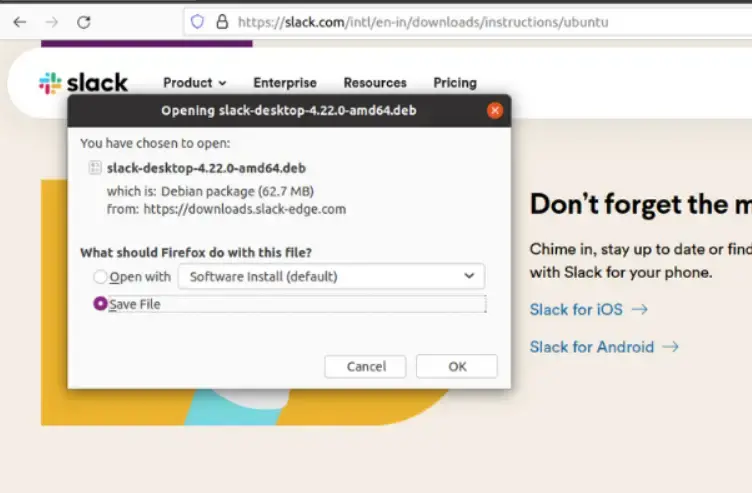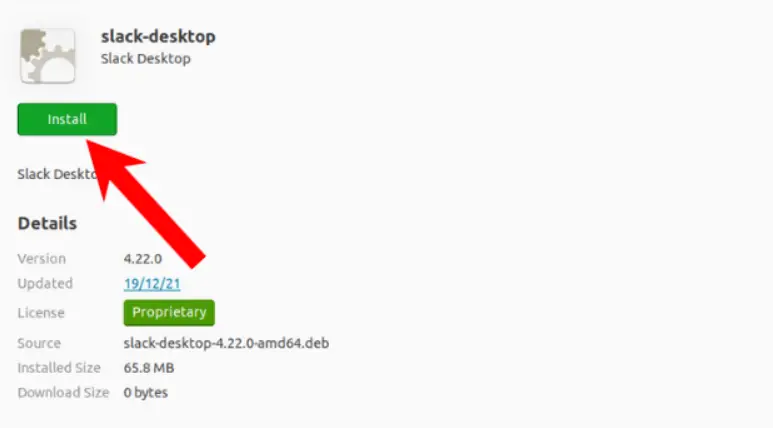Installing Deb Files in Linux
In this Linux article, we will learn how to install .deb (Debian Package) files on Linux systems. We will also see how to remove .deb files after installation.
More importantly, we will learn different ways to install .deb files on Linux systems.
Manually Installing DEB Files in Linux
We can install the .deb file by simply clicking on the file and selecting the install package option.
First, we need to download a .deb file. Let's say we want to install slack.deb on our Linux system.

After downloading the slack.deb file, we double-click on the file, which will load the contents of the package. After loading the package contents, we need to click on the install button as shown.

This is one of the ways we can install .deb files using the graphical desktop (GUI).
Install DEB file in Linux using terminal
If we want to install a .deb file using terminal in Linux, then dpkg command can help us install .deb files.
First, we open the terminal. Then we need to change the current directory to the downloaded directory where the slack.deb file is stored.
We use this command to change directory.
$ cd \Downloads

After this, we need to use the following command and press the enter button. The following command will execute the .deb slack file and install the package in our Linux system.
$ sudo dpkg -i slack.deb

Before starting to install the slack.deb file, the system will ask the user to enter the administrator password.
Deleting DEB Files in Linux Using Terminal
With the help of dpkg command, we can remove a .deb file in Linux system. We can remove slack.deb package on Linux using the following command.
$ sudo dpkg remove slack.deb
Running the above command in terminal will successfully remove the slack.deb file.
I hope this article helped you understand how to install .deb files on Linux operating systems.
For reprinting, please send an email to 1244347461@qq.com for approval. After obtaining the author's consent, kindly include the source as a link.
Related Articles
How to decompress x.tar.xz format files under Linux
Publish Date:2025/04/08 Views:186 Category:OPERATING SYSTEM
-
A lot of software found today is in the tar.xz format, which is a lossless data compression file format that uses the LZMA compression algorithm. Like gzip and bzip2, it supports multiple file compression, but the convention is not to compr
Summary of vim common commands
Publish Date:2025/04/08 Views:115 Category:OPERATING SYSTEM
-
In Linux, the best editor should be vim. However, the complex commands behind vim's powerful functions also make us daunted. Of course, these commands do not need to be memorized by rote. As long as you practice using vim more, you can reme
Detailed explanation of command return value $? in Linux
Publish Date:2025/04/08 Views:58 Category:OPERATING SYSTEM
-
? is a special variable. This variable represents the return value of the previous command. That is to say, when we run certain commands, these commands will return a code after running. Generally, if the command is successfully run, the re
Common judgment formulas for Linux script shell
Publish Date:2025/04/08 Views:159 Category:OPERATING SYSTEM
-
In shell script programming, predicates are often used. There are two ways to use predicates, one is to use test, and the other is to use []. Let's take a look at how to use these two methods through two simple examples. Example 1 # test –
Shell script programming practice - specify a directory to delete files
Publish Date:2025/04/08 Views:98 Category:OPERATING SYSTEM
-
Usually, in Linux system we need to frequently delete some temporary files or junk files. If we delete them one by one manually, it will be quite troublesome. I have also been learning shell script programming recently, so I tried to write
Use of Linux command at - set time to execute command only once
Publish Date:2025/04/08 Views:158 Category:OPERATING SYSTEM
-
This article mainly involves a knowledge point, which is the atd service. Similar to this service is the crond service. The functions of these two services can be similar to the two functional functions of javascript. Those who have learned
Use of Linux command crontab - loop execution of set commands
Publish Date:2025/04/08 Views:170 Category:OPERATING SYSTEM
-
Compared with at , which executes a command only once, crontab, which we are going to talk about in this article, executes the set commands in a loop. Similarly, the use of crontab requires the support of the crond service. The service is s
Linux practice - regularly delete files under the directory
Publish Date:2025/04/08 Views:198 Category:OPERATING SYSTEM
-
Since we want to delete the files under the directory regularly, we need to use the Linux crontab command. And the content format of each work routine is also introduced in the format of each crontab work. Similarly, we need to use shell sc
How to use the Linux file remote copy command scp
Publish Date:2025/04/08 Views:151 Category:OPERATING SYSTEM
-
Scp copies files between two hosts over the network, and the data is encrypted during transmission. Its underlying layer uses ssh for data transmission. And it has the same authentication mechanism and the same security level as ssh. When u

